Kans Grass Saccharum spontaneum Uses, Research, Remedies, Side Effects
Kans Grass flowers were used as pen in ancient India to write on leaf papers. Kasha- Saccharum spontaneum is a herb mentioned in Ayurveda for the treatment in conditions of burning urination, renal calculi, menorrhagia, bleeding piles and to improve the quantity of breast milk in lactating women.
Latin name- Saccharum spontaneum Linn.
Family- Gramineae (yava kula)
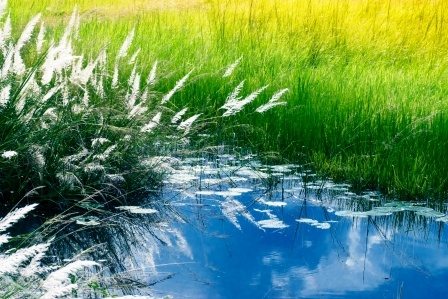
Table of Contents
Vernacular names
Names in different languages:
Hindi name-Kasa
English name – Kans Grass
Assamese name- Khagori, Kahuva
Bengali name- Keshe
Gujarati name- Kansado
Marathi name- Kasai
Telugu name- Rellu gaddi
Sanskrit synonyms
Sanskrit Synonyms of Kasha:
Ikshugandha- The grass has a sell like that of sugarcane plant
Sita Pushpa – white coloured flowers
Nadeya – found on river banks
Lekhana – the flowers are used for writing, as pen.
Shweta chamara Pushpa – flowers and inflorescence look like a white hand fan
Potagala, Kandekshu, Kakekshu, Vayasa Ikshu,
Ikshvari, Ikshu Kanda, Ikshuraka, Ikshu Kusuma, Ikshvalika,
Darbha Patra, Kanthala Karaka,
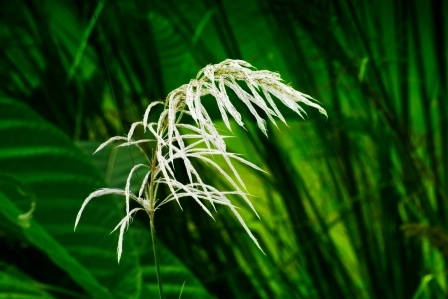
Morphology
Morphology of Kans Grass:
It is a perennial grass, growing up to three meters in height, with spreading rhizomatous roots. The stem is a little hard and the leaves are thin, blunt edged. The flowers are white in color and appear in clusters, seen in the winter season. The plant is found all over the plains of India
Properties, part used, dosage
Medicinal properties of Kans Grass:
Rasa (Taste) – Madhura (Sweet), Kashaya (Astringent)
Guna (Qualities) – Laghu (Light), Snigdha (Slimy)
Vipaka – Madhura (Undergoes sweet taste after digestion)
Veerya (Potency) – Sheeta (Cold)
Karma (Actions) – Ripened fruit is Vata pitta shamaka (reduces vitiated vata and pitta dosha)
Pharmacological action – Diuretic, Lithotriptic, Haemostatic,Laxative, Aphrodisiac
Part used- Root
Dosage-
Decoction- 50 to 80 ml
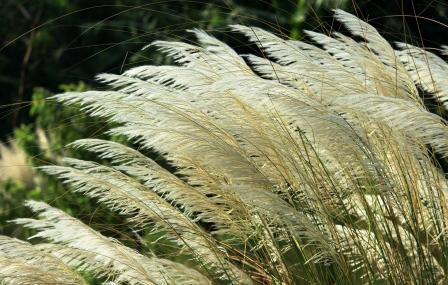
Chemical composition
Chemical composition of Saccharum spontaneum:
The dried grass yields reducing sugars along with glucose, xylose, galactose and rhamnose.
Uses of Kasha
- Decoction of the root of Kansh is given in a dose of 50-60 ml mixed with sugar candy to treat conditions of burning micturition, burning sensation of body and excessive thirst.
- The root of Saccharum spontaneum is boiled in cow milk and given in a dose of 50-60 ml to lactating women to improve the quantity of breast milk.
- Decoction of the root is given in a dose of 50 ml mixed with Gokshura powder (Tribulus terrestris) in the condition of renal calculi as part of treatment.
- In the condition of bleeding pile, the cold infusion of the root of is given in a dose of 40-50 ml
- To control bleeding in menorrhagia and blood mixed diarrhea, the decoction of the root of Saccharum spontaneum is given in a dose of 50 ml.
- Traditionally, Kansh leaves are kept in food during Solar and Lunar eclipse, to protect the food from radiation.
- Kansh is used for thatching in North India. It grows in barren land, near rivers and on the border of cultivated land so that crops inside can be protected from wild animals. Probably its aroma was acting as a deterrent.
Sanskrit verse
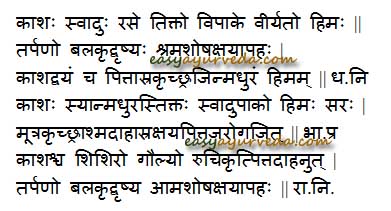
Traditional uses, Indications
Traditional uses:
Tarpana – nourishing, soothing
Balakrut – improves strength and immunity
Vrushya – aphrodisiac, improves vigor
Shramahara – Relieves tiredness, fatigue
Indicated in –
Shosha – emaciation, dehydration
Kshaya – depletion of body tissues, weight loss, tuberculosis
Pittasra – Raktapitta –Bleeding disorders such as nasal bleeding, heavy periods, etc
Mutrakruchra – dysuria
Ashmari – Kidney and bladder stones
Daha – burning sensation, as in gastritis, neuropathy, burning sensation in eyes etc
Ama – A product of indigestion and altered metabolism
Adverse effect
No adverse effect is known or reported after the use of Kasha.
Interaction with medicines, supplements
Can this be used while taking Homeopathic medicine?
Yes. This product does not react with homeopathic medicine.
Can this medicine be continued while taking supplements like multivitamin tablets, Omega 3 fatty acids etc?
Yes. Generally, this product goes well with most dietary supplements. However, if you are taking more than one product per day, please consult your doctor for an opinion.
With western
medicines
Seek your
doctor’s advice if you are taking this product along with other western
(allopathic / modern) medicines. Some Ayurvedic herbs can interact with modern
medicine.
If both Ayurvedic and allopathic medicines are advised together, then it is
best to take Allopathic medicine first, wait for 30 minutes and then take the
Ayurvedic medicine.
Ayurvedic medicines
Ayurvedic medicines containing Kasha:
Stanyajanana kashaya:: It is a decoction, used to induce/ improve breast milk production in a lactating mother.
Gynakot tablet: It is a proprietary tablet used to regulate female hormones and prepares the uterus ideal for reproduction.
Ashmarihara kashaya: It is a decoction used to treat renal calculi.
Chandanadi taila: It is a medicated oil used to relieve burning sensation, dizziness, etc. It is used for external applications.
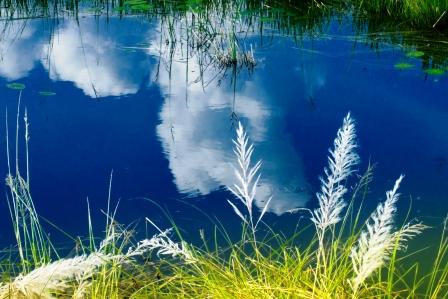
Mutra virechaniya kashaya: It is a decoction used to treat renal calculi and difficulty in micturition.
Trikantaka ghrita: It is a medicated ghee used for preparatory procedure for Panchakarma and also as medicine, used mainly for diseases related to urinary system, diabetes and calculus.
Amlycure DS capsule: It is a proprietary Ayurvedic medicine used to strengthen liver corrective aim to provide therapeutic benefits in liver diseases & disorders.
Research
Research articles related to Saccharum spontaneum:
Anti- lithiatic activity: The ethanolic extract of roots of Saccharum spontaneum Linn. was evaluated for its antilithiatic activity in rats. Lithiasis was induced by oral administration of ethylene glycolated water (0.75%) in adult male wistar albino rats for 28 days. Treatment with ethanolic root extracts of S.spontaneum (200 and 300 mg / kg body weight) in group III and IV significantly (p< 0.05) in urolithiatic rats. Treatment with plant extract restored the levels and it brought back the values to near normal range in urolithiatic rats.
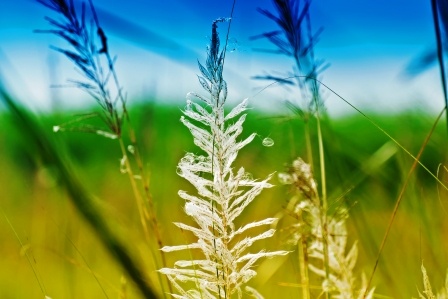
Hypo lipidemic action: The present investigation was aimed to study the effect of ethanolic extract of Saccharum spontaneum whole plant (ESSW) in attenuating hyperlipidemia which is associated with many cardiovascular diseases like atherosclerosis. Hyperlipidemia was induced in rats by feeding atherogenic diet (AD) for a period of 21 days. The oral administration of ESSW (100 and 200 mg/kg body weight) for 21 days significantly lowered the TC, TG and LDL-C levels while increases in HDL levels were observed in a dose dependent manner.
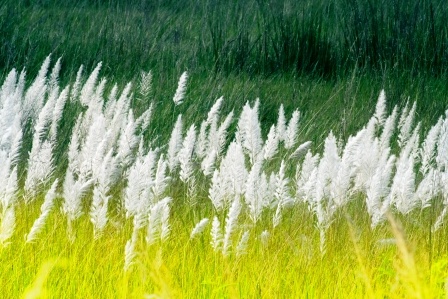
Classical categorization
Charaka samhita-
Mutravirechaniya – group of herbs used in imparting normal colour and composition of urine
Stanyajanana – lactation promoting group of herbs
Sushruta Samhita- Trina panchamoola – group of five grasses
Bhavapakasha- Guduchyadi varga
Dhanvantari Nighantu- Karaveeradi varga
Raja Nighantu- Shalmalyadi varga
Scientific classification
Kingdom: Plantae
Order: Poales
Family: Poaceae
Genus: Saccharum
Species: S. spontaneum
Author: Dr.B.K.Prashanth M.D (Ayu), Ph.D
E mail: [email protected]
Click to consult Dr Prashanth BK
Sthanika Karma (Systemic Action)
Internal administration-
Digestive system –Indicated in bleeding per rectum, Bleeding hemorrhoids, Indigestion due to pitta imbalance etc.
Circulatory System – Indicated in Bleeding disorders, chest injury
Reproductive system – Indicated in Menorrhagia, Metrorrhagia etc. increase breast milk production.
Excretory system – It is indicated in Renal calculi, increases urine output and cleanses the bladder
Tapakrama – Reduces burning sensation
Satmikarana – Indicated in Generalized weakness, strengthens the body.










